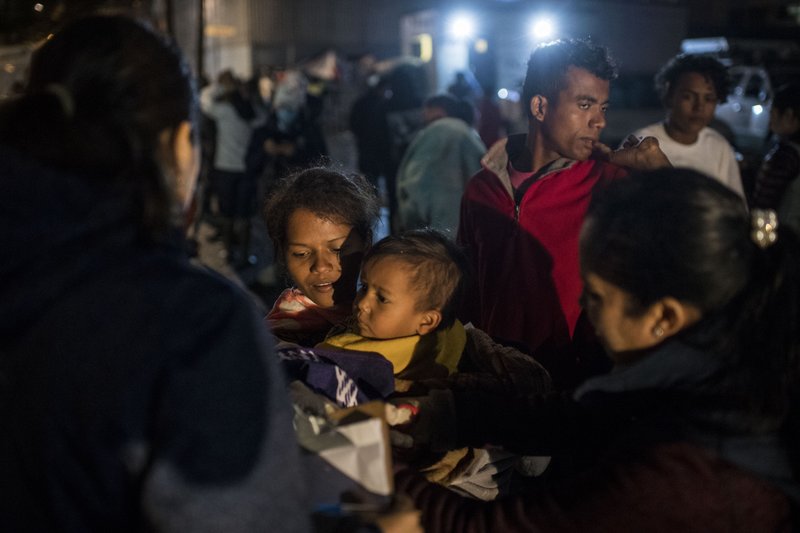TIJUANA, Mexico -- Mexican authorities have begun moving Central American migrants from a crowded, increasingly unsanitary encampment to a government-run shelter farther from the U.S.-Mexico border, raising fears among members of the migrant caravan that their dreams of asylum in the United States will be dashed.
Buses arrived to take people to the new shelter starting Thursday evening as rain pelted the existing encampment in a sports complex, deepening the misery of more than 6,000 migrants stuck in limbo there amid trash and mud. By Friday morning, about 755 people had been taken to the new shelter, a shuttered concert theater, El Barretal, about 11 miles from the border in the Los Torres de Matamoros section of Tijuana.
But many migrants, the bulk of them from Honduras, were staying put, suspicious of Mexican authorities' intentions.
"People are distrustful that it's an immigration trick, that it's not what they say it is and that they will really be deported," said Amelia Vitale, a doctoral candidate in anthropology at the University of Michigan and an immigration expert who has traveled with migrant caravans for years. "It's happened before in southern Mexico."
In the meantime, many of the migrants are trying to get permits to stay and work legally in Mexico, she said. "They also have no idea where they are going -- which makes them worried that they won't be near banks, where families are sending them money, or stores where they can buy food, since the food here doesn't always stretch. Many of them have part-time jobs nearby that they've picked up. There are a lot of reasons people are hesitating."
Unsanitary conditions at the encampment have raised concerns among aid workers and humanitarian organizations that the migrants, packed into a space intended for half their number, are susceptible to outbreaks of disease. Already, many are suffering from lice infestations and respiratory infections, officials said.
Mexican authorities touted the advantages of the new shelter, pointing out that the Mexican navy is on the scene to handle food distribution and that transportation to a job fair will be provided. They expressed hope that those who initially took the buses to the new site would report back to others and encourage them to come.
"It's a much better place, and all of the help and government services will be there," said Edgar Corzo Sosa, a spokesman for the Mexican Commission on Human Rights.
On Friday, those who had arrived the night before woke to find no water or food available, with some wondering whether they made the right choice to leave the sports complex. The former site, while unsanitary, is much closer to both government services and the U.S. border.
But, while cramped, the sleeping quarters were beneath a tin roof that shielded the migrants from the morning rain. A row of portable toilets also stood nearby, and a federal health care worker stationed there was checking on some of the migrants.
Standing in a center courtyard, some of the migrants debated whether they were better off.
"We have to appreciate the little they give us," said Wilson Mejia, 20, a Guatemalan national, after another man complained that the new shelter was "the worst."
"Over there, we were inundated by the rain," Mejia said about the sports complex. "There was black [sewer] water running around the edges. We have to adjust to what little they give us. It's not their obligation. We are not in our country."
Cesar Palencia, head of the migrant affairs office dealing with the caravan, said the new shelter has four roofed areas and "all the government services." The United Nations and other organizations will have a presence there, he said. Yet, it has been difficult to get people to leave the sports complex voluntarily, he added.
"We haven't had the response that we want," he said. "We didn't think that so few would accept the offer. This was never an adequate space for them ... The idea is that they will voluntarily leave between today and tomorrow."
Meanwhile, U.S. officials said Friday that the number of U.S. active duty troops at the southern border would drop from 5,600 to about 4,000, and their deployment would be extended through the end of January, under a new request from the Department of Homeland Security.
Defense Secretary James Mattis is traveling and has not yet approved the troop proposal. But military officials have been working with the agency on the request and it is expected to get approval.
Most of the troops have been deployed in Texas, far from where the migrants eventually arrived in Tijuana. Soldiers have strung vast amounts of concertina wire and transported Border Patrol agents but have not been engaged in any law enforcement activities, which would be prohibited under U.S. law.
The initial deployment was scheduled to end Dec. 15, but Mattis and other officials had said it could be extended.
Information for this article was contributed by Sarah Kinosian, William Branigin and Antonio Olivo of The Washington Post; and by Lolita C. Baldor of The Associated Press.
A Section on 12/01/2018
